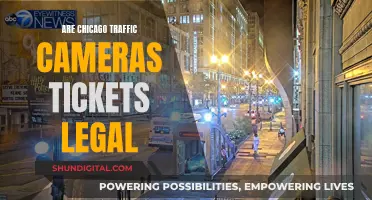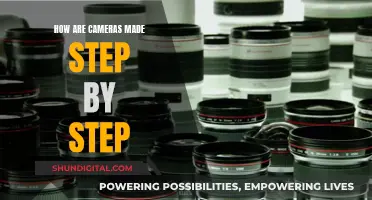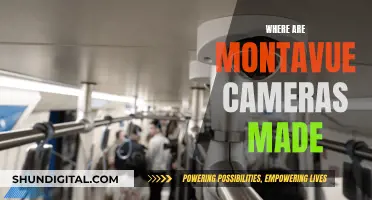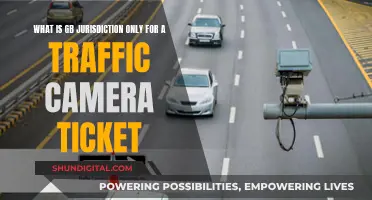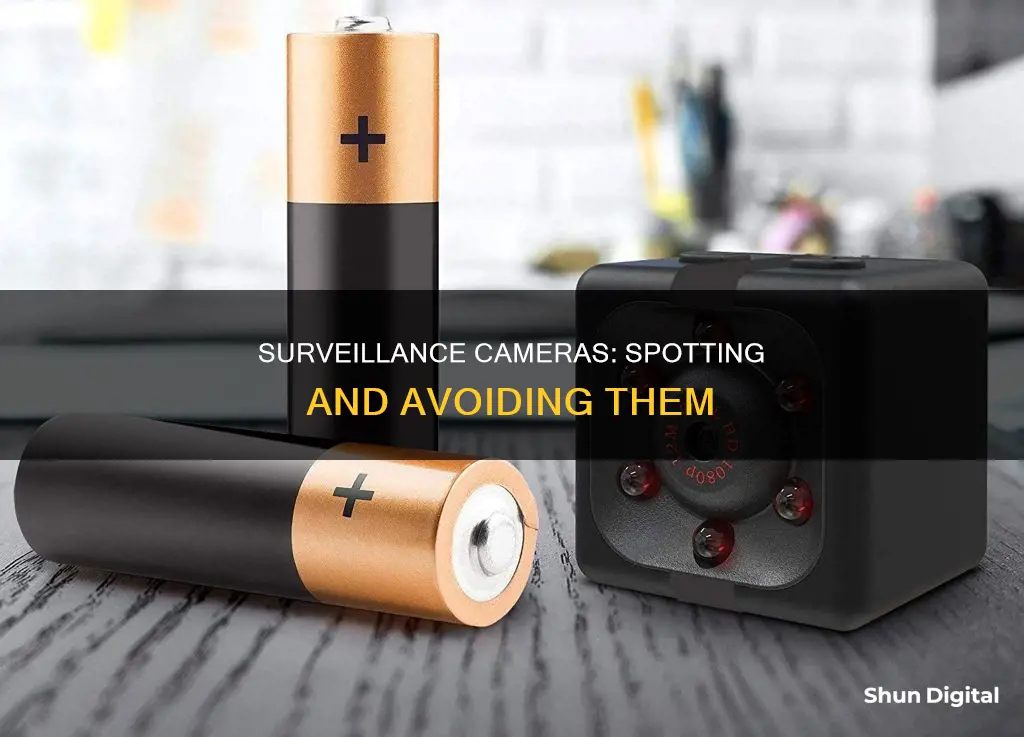
Surveillance cameras are a real danger and can be hidden anywhere, from hotel rooms to public restrooms. They are often disguised as commonplace household objects such as smoke detectors, clocks, or power outlets. Detecting them can be challenging, but there are several methods and tools that can help. One simple way is to carefully scan the environment for suspicious objects or wires. Another method is to use a smartphone to detect infrared lights, which are often used for night vision in hidden cameras. Additionally, smartphone apps can be used to scan Wi-Fi networks for unknown devices or to detect lens glare. For more accurate results, professional detectors or sensors that use radio frequency signals can be purchased. These tools can help locate hidden cameras and ensure privacy and safety.
| Characteristics | Values |
|---|---|
| Scan the environment carefully | Check for suspicious objects, wires, lights, or lenses. |
| Turn off the lights in the room | Use a flashlight to detect reflective glass surfaces. |
| Use a smartphone | Download a "detect hidden cameras" app or use the front camera to detect infrared lights. |
| Use a professional detector or sensor | Buy a professional RF signal detector online. |
| Check the mirrors | Hold your fingernail to the mirror to detect a gap, indicating a real mirror. |
What You'll Learn

Scan the environment carefully
When scanning the environment for surveillance cameras, it's important to be thorough and take your time. Ask yourself, "If I were the perpetrator, where would I hide a camera?" This mindset shift can help you spot potential hiding places.
Some of the most common places to find indoor hidden cameras include air filter equipment, stuffed toys, couch cushions, tabletops, shelves, and wall or alarm clocks. For outdoor cameras, check the roof of the house and the doorbell.
Be on the lookout for objects that seem out of place, bulky, or unusual. Spy cameras can be disguised as commonplace household objects, so it's important to inspect anything that stands out. Pay attention to suspicious wires, lights, or lenses, which are often tell-tale signs of hidden cameras. If you find unusual power outlets or adapters, unplug them immediately.
Listen carefully as you walk through the room. Some hidden motion-sensing cameras emit an almost inaudible buzz when in operation. Trust your instincts—if something seems amiss, investigate further.
When scanning for cameras, it's helpful to turn off the lights in the room. Most hidden cameras have red or green LEDs that blink or shine in low-light conditions. Use a flashlight to carefully scan the room, paying close attention to any reflective lights that could indicate a hidden lens.
GoPro Hero 7: Does It Shoot RAW?
You may want to see also

Turn off the lights and use a flashlight
Turning off the lights and using a flashlight is an effective way to detect hidden surveillance cameras. This method works because the lenses of surveillance cameras are made of glass, which is reflective.
To use this method, start by drawing the curtains and turning off the lights to make the room as dark as possible. Then, turn on your flashlight and slowly pan it around the room, examining any suspicious positions from different angles. If there is a hidden camera, you should see a reflective light from the lens.
This technique works best in dark conditions, so it is ideal for night-time or enclosed spaces. It can be used to detect wired or wireless cameras in a variety of locations, such as your car, stores, living room, or bedroom.
However, it is important to note that this method requires precision and quick action. If the flashlight beam moves away from the camera lens, your face may be revealed. Additionally, this method may not be subtle, as the sudden flash of light could alert vigilant guards to your presence.
Traffic Camera Tickets in Tennessee: Do You Have to Pay?
You may want to see also

Use your smartphone
Using Your Smartphone to Detect Surveillance Cameras
It is possible to detect surveillance cameras using your smartphone. Here are some methods you can try:
Scan the Wi-Fi Network
Use an application like Fing to scan the Wi-Fi network for unknown devices. This method will help you find cameras that are connected to the network and will show up as "IP Camera" or "Generic". However, this approach will not detect cameras that are not connected to the network.
Detect Infrared (IR) Lights
Most surveillance cameras use infrared for night vision. While these IR rays are invisible to the naked eye, your smartphone camera can detect them.
To determine if your phone can detect infrared, use an infrared remote (such as a TV remote). Point the remote at your phone's camera and press a button. If you see a light on the screen, your phone can detect infrared.
Once you've identified which camera to use (either the front or back camera), turn off the lights in the room and start looking for glowing lights through your phone's camera. These lights will typically appear purple, but can also look white or blue.
Detect Light Reflecting from a Lens
You can use a mobile application to detect reflections from camera lenses. For Android users, the Glint Finder app is designed to spot reflections from lenses. iPhone users can try the Hidden Camera Detector app, which has been featured on broadcast news shows.
Find Bluetooth Cameras
If you suspect Bluetooth cameras are in use, enable Bluetooth on your phone and scan for available devices. Take note of any device names that appear and run a web search to see if they resemble known camera products.
Detect Electromagnetic Fields
There are dedicated mobile applications that can detect hidden cameras using the device's electromagnetic (EM) field. For example, the Hidden Camera Detector app for Android displays a red glow when the smartphone is near a camera. Use the direction of the glow to find the camera's position.
Use a Flashlight
Turn off the lights in the room and use a flashlight to slowly scan the area. Look for any reflective lenses that may indicate the presence of a hidden camera.
While these methods can help detect surveillance cameras, it is important to note that there is no guaranteed way to find all hidden cameras.
Galaxy S7 Camera Mode Mystery: Where Did It Go?
You may want to see also

Use a professional detector
Using a professional detector is one of the most effective ways to find hidden cameras. These devices are designed to detect radio frequency (RF) signals emitted by cameras. They provide a reliable and targeted approach to locating hidden cameras and can be purchased online or in stores, with prices ranging from as low as $20 to more expensive options.
- Purchase a Professional Detector: You can buy professional RF detectors from online stores like Amazon or specialised shops. The price can vary, so choose one that fits your budget and needs. Some popular brands include JMDHKK, SpyHawk, Jepwco, and Latnex.
- Prepare the Area: Before using the detector, turn off and unplug all electronic devices that emit radio signals, such as kitchen appliances, baby monitors, routers, modems, and TVs. These devices may interfere with the detector's performance.
- Perform the Scan: Turn on the RF detector and carefully sweep it around the room. The detector will typically emit an audible beep or visual alert when it detects a signal, helping you pinpoint the location of the hidden camera.
- Narrow Down the Search: If the detector picks up a signal, move closer to the suspected area and adjust the sensitivity settings if available. This will help you narrow down the search and accurately locate the hidden camera.
- Identify the Camera: Once you have located the camera, you can identify it by looking for common characteristics such as lenses, wiring, or other components. Hidden cameras are often disguised as everyday objects, so be vigilant and inspect any suspicious items.
- Take Necessary Actions: If you find a hidden camera, do not touch or remove it as it may contain fingerprints useful for an investigation. Instead, document the discovery by taking pictures or videos, and contact the local authorities for further guidance.
Using a professional RF detector is a reliable method to detect hidden cameras. However, it is important to follow the instructions provided with the device and be mindful of potential interferences from other electronic devices.
Fight Speeding Tickets: Know Your Rights, Louisiana
You may want to see also

Check mirrors
Checking mirrors is a crucial step in detecting surveillance cameras. Here are some detailed instructions on how to do it effectively:
Check for Two-Way Mirrors:
Place your fingertip on the mirror and observe the gap between your finger and its reflection. If there is no gap and your fingertip aligns directly with the reflection, it indicates a two-way mirror, which could conceal a hidden camera. In such cases, you can try to remove the mirror or continue searching for other hidden cameras. However, if there is a noticeable gap between your finger and the reflection, it is likely a standard mirror with no hidden camera.
Examine the Mirror for Signs:
Look for any small holes or lenses on the mirror's surface, as pinhole cameras are often hidden behind tiny holes. Also, check for unexpected lights or blinking indicators, which could be signs of wireless cameras. Additionally, inspect the area behind or around the mirror for any suspicious wiring, as some hidden cameras may require an external power source.
Use a Flashlight:
Turn off the lights in the room and shine a flashlight directly at the mirror. Look for any reflections or small lights that could indicate the presence of a camera lens. This technique works best in a dark environment, as the camera lens may reflect the light back, making it easier to spot.
Use a Smartphone Camera:
Many smartphones have a flash feature for taking photos. Use this flash to illuminate the mirror and examine the image for any signs of small holes or lenses. Alternatively, you can download a dedicated hidden camera detector app that uses your smartphone's camera to scan for infrared lights or radio frequency signals emitted by hidden cameras.
Hire a Professional:
If you suspect a hidden camera behind a mirror, consider hiring a professional with the proper tools and expertise. They can conduct a thorough inspection and detect even the most well-concealed cameras.
Remember, when checking mirrors for surveillance cameras, it is important to be vigilant and pay attention to any unusual signs or features. Additionally, combining multiple detection methods can increase your chances of successfully detecting hidden cameras.
Exploring Zmodo Camera's Versatile Modes and Their Uses
You may want to see also




